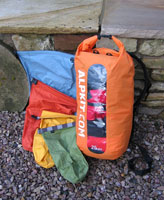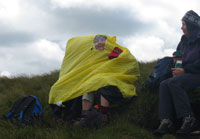General info > Getting started > Keeping dry
Keeping out of the rain
One thing that seems to be pretty unavoidable, wherever you walk, is rain – even in the so-called summer. In the last few years the skies have opened on us in South America, North Africa, Spain, France, Switzerland, Italy, Nepal and even in Cumbria. On most occasions we have been reasonably well prepared, although like most regular walkers we have been caught out from time to time as well. So what have learnt from our soggy experiences?
Most people’s priority is to keep themselves dry. In the darker and wetter months of the year it’s usual to carry decent wet weather gear, but it’s less appealing to have all that heavy stuff on your back when all you’re in for is a summer shower. It can be a mistake to turn your nose up at some simple solutions. In Peru, at the start of the Inca Trail, we were offered cheap ponchos for a couple of dollars each. Equipped with our fabulously expensive breathable waterproofs we sniffed at them. But when water fell out of the sky at an equally fabulous rate, as it can do in the Andes, our incredibly posh and technical waterproofs became drenched. Meanwhile our guides and porters donned their brightly covered ponchos and remained completely dry. In the Himalaya in Nepal we had a repeat experience, only this time when the heavens opened our guides simply put up their umbrellas. We didn't have an umbrella, of course, so we got soaked. Of course cheap plastic ponchos and umbrellas only really work when the rain is coming straight downwards. Add a bit of wind and you’ll probably want something else.
I have tried all sorts of lightweight waterproof tops and my current favourite is a Paramo, though there are plenty of other good makes. Now a jacket like this is not cheap – a Paramo is typically around £200. However arguably a good waterproof top is the most important thing to have, whatever the season. Make sure you get one with a good hood, as keeping your head warm and dry is vital if things start to turn for the worse.
In spring, summer and autumn I’m less bothered about keeping my legs completely dry. A quick-drying pair of trousers may be adequate for many outings or indeed a pair of shorts (because your skin will dry a lot quicker than any fabric). If I’m venturing up a hill I’ll generally put in a pair of very lightweight and inexpensive over-trousers. I currently have a pair of Craghoppers which fold up into a small bag and do a pretty good job of keeping out light rainfall. A pair of gaiters can be a great help if you’re going through long wet grass and heather, which will often get you wetter than the water falling from the sky. You don’t need to spend much to get a decent pair.
Keeping the water off yourself is one thing; keeping it out of your belongings is another. Very few small daysacks keep out the rain for long; more now have rainproof covers which slip out of a zip pocket on the sack and encase it. However in stronger winds these can blow off and then, rather than keeping your sack dry, they become a very annoying piece of fabric flapping around your face. Even a reasonably waterproof sack lets the rain in if you open it up to get things out. In fact I’ve had quite a few sacks which seem to be better at keeping the water in than keeping it out.
 The traditional solution is to have a plastic sack liner and these can be bought cheaply from outdoor shops or improvised from a bin-liner or big plastic bag. Rather better is to keep your belongings in a set of dry sacks. These are sacks made from waterproof material with a roll-top. You roll the top a few times so no water can get in and then clip it to stop it unrolling. Originally these were made for serious watersports like kayaking and sailing and the fabric was often quite heavy. Now you can buy lightweight sets in different colours and sizes for just a few pounds. Colour coding is great for identifying which sack has your sandwiches in and which your spare socks (you really don't want to muddle them up).
The traditional solution is to have a plastic sack liner and these can be bought cheaply from outdoor shops or improvised from a bin-liner or big plastic bag. Rather better is to keep your belongings in a set of dry sacks. These are sacks made from waterproof material with a roll-top. You roll the top a few times so no water can get in and then clip it to stop it unrolling. Originally these were made for serious watersports like kayaking and sailing and the fabric was often quite heavy. Now you can buy lightweight sets in different colours and sizes for just a few pounds. Colour coding is great for identifying which sack has your sandwiches in and which your spare socks (you really don't want to muddle them up).
Taking the concept one stage further is a British company called Alpkit. They have taken the roll-top dry bag and simply added a padded back and some carrying straps to make a dinky, completely waterproof, day sack. I’ve got one of these and I think it’s fantastic. You really don’t have to worry about water getting in, although I still keep stuff in dry bags inside so things don’t get wet when I’m rummaging through it. On the larger versions there’s a see-through panel to allow you see where you’re rummaging. Best of all Alpkit’s bag, called the Gourdon, starts from around £22.50 depending on the capacity. You don’t have to have one in a garish orange (my one pictured here I use as my mountain rescue grab bag so I like it to be highly visible) – they come in more muted colours, including a very muted black. So popular are these bags that Alpkit periodically run out of them, so you have to keep an eye on the Alpkit website and buy one when you can.
There are some bits of kit you’ll want to keep out of the wet even when you are using them, like your camera and mobile phone. For these I generally use an Aquapac. Aquapac have a very extensive range including cases with clear lenses for cameras. You can operate a mobile phone through the plastic and hear through it too, so you don’t need to remove the phone even if you are making a call. It may look a bit clumsy but it works.
 Finally, if I’m out for a few hours in more exposed terrain, or just expect to be eating my lunch in a downpour, I’ll carry my two-person bothy. This is really nothing more than a large bivi bag made in lightweight material, with some air vents, a see-through panel so you can watch the rain and other poor people from the inside and an integrated stuff sack. All you do is pop it over your heads and sit on the edges to keep it down. Bothy bags were pioneered by Karrimor with their Kisu (in fact many people call them kisus, rather like vacuum cleaners are called Hoovers). Now a number of manufacturers make them. Mine is by Terra Nova and cost around £30; larger sizes take groups of four and upwards and cost a little more. You can get them from any good outdoor retailer or website. Now you may think it looks pretty silly sitting inside a large brightly coloured bag – we’re certainly doing a good job of looking silly in the picture here – but these bags do a fantastic job of keeping you dry and warm. That could just mean having a much more comfortable lunch break than everyone else on the hill or, in an emergency, it could genuinely make the difference between your returning safely or not.
Finally, if I’m out for a few hours in more exposed terrain, or just expect to be eating my lunch in a downpour, I’ll carry my two-person bothy. This is really nothing more than a large bivi bag made in lightweight material, with some air vents, a see-through panel so you can watch the rain and other poor people from the inside and an integrated stuff sack. All you do is pop it over your heads and sit on the edges to keep it down. Bothy bags were pioneered by Karrimor with their Kisu (in fact many people call them kisus, rather like vacuum cleaners are called Hoovers). Now a number of manufacturers make them. Mine is by Terra Nova and cost around £30; larger sizes take groups of four and upwards and cost a little more. You can get them from any good outdoor retailer or website. Now you may think it looks pretty silly sitting inside a large brightly coloured bag – we’re certainly doing a good job of looking silly in the picture here – but these bags do a fantastic job of keeping you dry and warm. That could just mean having a much more comfortable lunch break than everyone else on the hill or, in an emergency, it could genuinely make the difference between your returning safely or not.
David Stewart